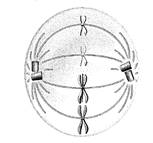
Concept explainers
Introduction:
In animals the sexual life cycle involves meiosis. Meiosis involves two consecutive cell divisions called meiosis I and meiosis II. The two divisions produce a set of four haploid daughter cells that are not identical. Meiosis is important because it results in
Answer to Problem 6A
Correct answer :
The correct answer is option D. they will divide into sister chromatids.
Explanation of Solution
Explanation/justification for the correct answer:
OptionD. they will divide into sister chromatids −During metaphase II, as can be seen in the given diagram, the haploid chromosomes are lined up at the equator of the cell. The spindle fibers attach to the centromere of each chromosome. The next stage is anaphase II during which the sister chromatids are pulled apart at the centromere by the spindle fibers. The sister chromatids then move towards the opposite poles of the cell. Hence, this is the correct option.

Explanation for incorrect answer:
Option A. they will experience replication- After metaphase II, the sister chromatids separate and move to opposite poles. They do not undergo replication.Hence, this is not the correct option.
Option B. they will experience fertilization- After metaphase II, the sister chromatids separate and move to opposite poles. They do not undergo fertilization.Hence, this is not the correct option.
Option C. their number per cell will be halved- As can be seen in the given diagram, the pairs of homologous chromosomes are not lined up at the equator of the cell. Only haploid chromosomes are lined up at the equator. The number of chromosomes is already halved after meiosis I. After metaphase II, the sister chromatids separate and move to opposite poles. Hence, this is not the correct option.
Chapter 10 Solutions
Biology Illinois Edition (Glencoe Science)
Additional Science Textbook Solutions
Campbell Essential Biology with Physiology (6th Edition)
Campbell Biology in Focus (2nd Edition)
Concepts of Genetics (11th Edition)
Campbell Biology in Focus
Anatomy & Physiology (6th Edition)
Human Biology: Concepts and Current Issues (8th Edition)
 Human Anatomy & Physiology (11th Edition)BiologyISBN:9780134580999Author:Elaine N. Marieb, Katja N. HoehnPublisher:PEARSON
Human Anatomy & Physiology (11th Edition)BiologyISBN:9780134580999Author:Elaine N. Marieb, Katja N. HoehnPublisher:PEARSON Biology 2eBiologyISBN:9781947172517Author:Matthew Douglas, Jung Choi, Mary Ann ClarkPublisher:OpenStax
Biology 2eBiologyISBN:9781947172517Author:Matthew Douglas, Jung Choi, Mary Ann ClarkPublisher:OpenStax Anatomy & PhysiologyBiologyISBN:9781259398629Author:McKinley, Michael P., O'loughlin, Valerie Dean, Bidle, Theresa StouterPublisher:Mcgraw Hill Education,
Anatomy & PhysiologyBiologyISBN:9781259398629Author:McKinley, Michael P., O'loughlin, Valerie Dean, Bidle, Theresa StouterPublisher:Mcgraw Hill Education, Molecular Biology of the Cell (Sixth Edition)BiologyISBN:9780815344322Author:Bruce Alberts, Alexander D. Johnson, Julian Lewis, David Morgan, Martin Raff, Keith Roberts, Peter WalterPublisher:W. W. Norton & Company
Molecular Biology of the Cell (Sixth Edition)BiologyISBN:9780815344322Author:Bruce Alberts, Alexander D. Johnson, Julian Lewis, David Morgan, Martin Raff, Keith Roberts, Peter WalterPublisher:W. W. Norton & Company Laboratory Manual For Human Anatomy & PhysiologyBiologyISBN:9781260159363Author:Martin, Terry R., Prentice-craver, CynthiaPublisher:McGraw-Hill Publishing Co.
Laboratory Manual For Human Anatomy & PhysiologyBiologyISBN:9781260159363Author:Martin, Terry R., Prentice-craver, CynthiaPublisher:McGraw-Hill Publishing Co. Inquiry Into Life (16th Edition)BiologyISBN:9781260231700Author:Sylvia S. Mader, Michael WindelspechtPublisher:McGraw Hill Education
Inquiry Into Life (16th Edition)BiologyISBN:9781260231700Author:Sylvia S. Mader, Michael WindelspechtPublisher:McGraw Hill Education





